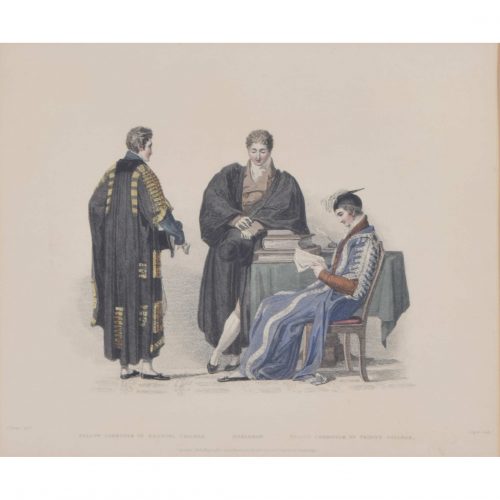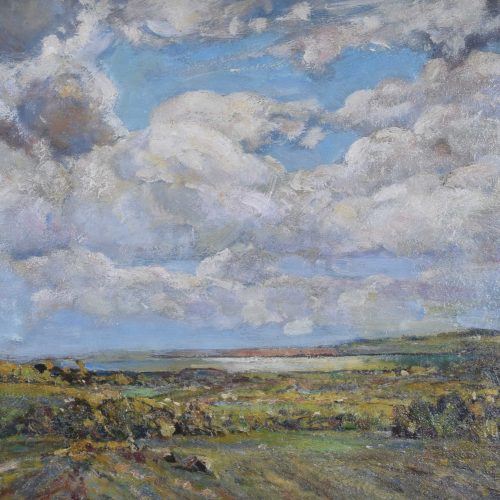-
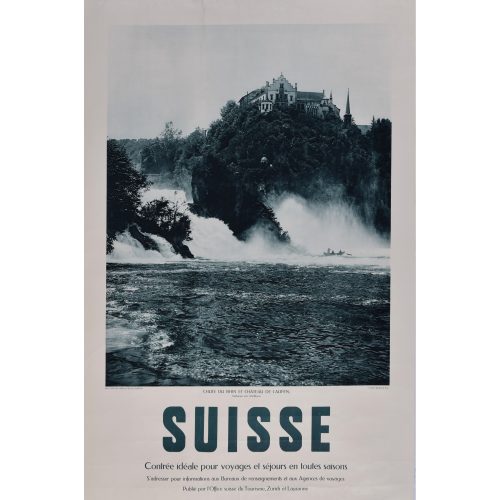
Suisse Chutes du Rhin
Original lithographic poster (1925) 40x25" If you are interested email info@manningfineart.co.uk or call us on 07929 749056. Condition: Generally good, a little edge wear. -
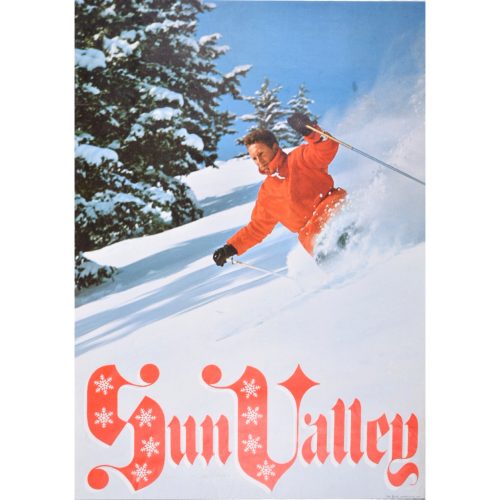
Sun Valley
Original lithographic poster c. 1965 76x51cm Published by LooArt Press, Colorado The resort was the first destination winter resort in the US and was developed by W A Harriman, the chairman of the Union Pacific Railroad to increase passenger numbers. The Austrian Count Schaffgotsch was instructed to find a suitable site and Sun Valley was born. Sun Valley was the site of the world's first chairlifts as single-seat chairs were installed in 1936 for the opening. The poster is believed to depict Sigfried 'Sigi' Engl, an Austrian who became director of Sun Valley Ski School in 1952 and made it famous for his innovative instructional methods. A few light creases and small spot towards top right. -
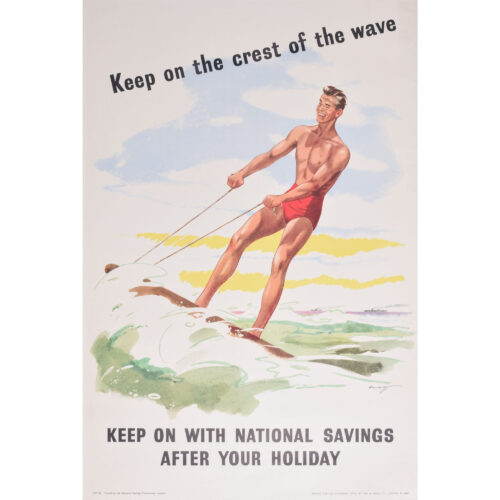
Keep on the Crest of the Wave
Original vintage poster 76 x 51 cm Issued by the National Savings Committee, London. Printed for HM Stationery Office by Fosh & Cross Ltd. An original vintage WW2 poster encouraging Britons to save via the National Savings scheme - like the cheery and composed surfer, we must keep saving to stay on the crest of the wave. Condition: generally very good; slight wear to right-hand margin. Not backed. If you are interested, please email info@manningfineart.co.uk or call us on 07929 749056. Click here for other original vintage National Savings posters. -
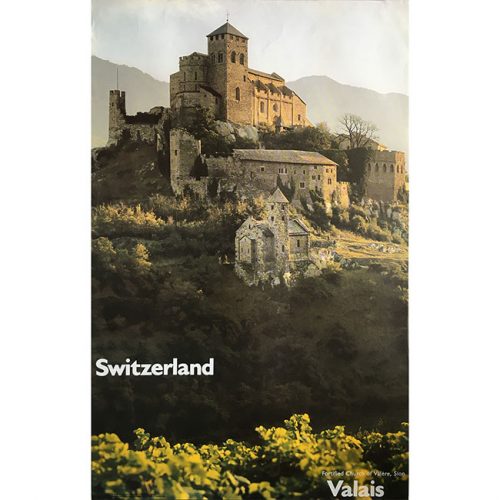 Anonymous Switzerland (Valais, Church of Rarogne) Photo:Giegel/SNTO Photolithographic poster 102x64cm If you are interested email info@manningfineart.co.uk or call us on 07929 749056.
Anonymous Switzerland (Valais, Church of Rarogne) Photo:Giegel/SNTO Photolithographic poster 102x64cm If you are interested email info@manningfineart.co.uk or call us on 07929 749056. -
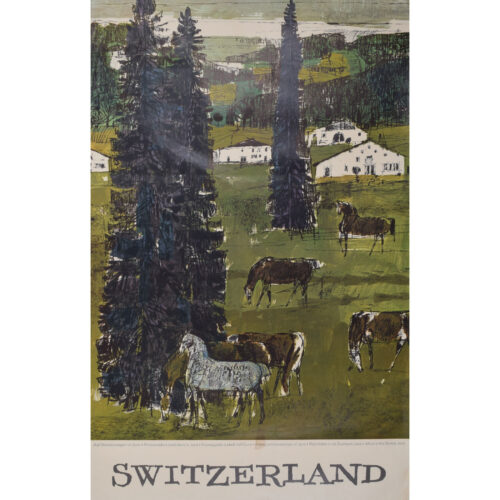
Hugo Wetli (1916 - 1972)
Switzerland - Afoot in the Swiss Jura
Original vintage poster 100 x 64 cm Hugo Wetli trained as a technical draughtsman and then became apprenticed to a private graphic studio. He worked in Geneva and Berne as a painter and draughtsman, also producing book illustrations and travel poster designs. In 1947 he studied at the Académie de la Grande Chaumière in Paris and then ran his own graphic design studio. Condition: generally very good; old tape stain under 'Paseo' approx 2 cm sq and extending almost invisibly into image; a few pin holes to corners; a little soft creasing. If you are interested, please email info@manningfineart.co.uk or call us on 07929 749056. Click here for other original vintage travel posters. -
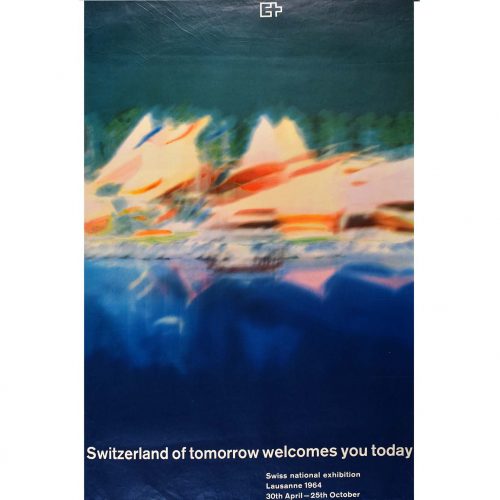
Switzerland of Tomorrow Welcomes You Today (1964)
Lithographic poster 152.4cm x 63.5 cm 1964 Original "Switzerland of Tomorrow" poster from the 1964 Swiss National Exhibition. As well as a brilliantly-designed futuristic poster printed in rich colours, it is a real piece of Swiss (and European) history. The poster is the English-language edition of a tourism-encouraging poster produced in several languages to welcome international visitors to an exhibition of Swiss innovation. Switzerland holds such an event four times per century, and the exhibitions often act as a portrait of contemporary culture, design, and politics. The 1964 National Exhibition in Lausanne offered a rather different representation of Switzerland from previous exhibitions. This was partly the result of its being held during one of the tensest periods of the Cold War; the attitudes of the Swiss were changing as the twentieth century progressed, as was the case for most Europeans, and the shadow of war had encouraged many citizens, businesses, and public bodies to reexamine their values. At "Expo 64", the nickname for that year's exhibition, the 'Gulliver Project' was introduced. The exhibition organisers made use of the character Gulliver (from Swift's 'Gulliver's Travels' to assess visitors' attitudes to daily life. A small questionnaire written by "Gulliver" was given to visitors, asking them questions about their societal attitudes, domestic lives, and work ethics, such as "Can you be a good Swiss and get up at 9am?". The theatre director Charles Apothéloz suggested having Gulliver ask these questions so as to make the questionnaire seem less serious, and to encourage people to answer truthfully. The questionnaire answers were compiled and analysed, but never published, as had been Apothéloz's initial intention. Charles Ascher discusses this at length in his 1965 article 'Gulliver in the Land of the Swiss'. If you are interested, please email info@manningfineart.co.uk or call us on 07929 749056. Condition: Good, pinholes to corners with some soft creases along bottom inch (would be hidden by mount). -
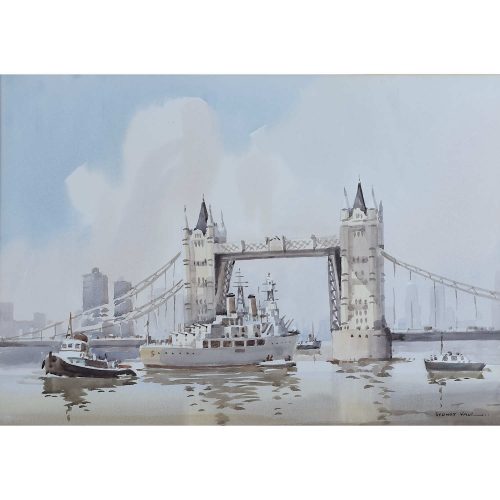
Sydney Vale F. R. S. A. (1916 - 1991)
A warship passing under Tower Bridge
Watercolour 35 x 50 cm Born in 1916, Sydney Vale was a Fellow of the Royal Society of Arts and a member of the prestigious Wapping Group of Artists from 1972 to 1991, which was formed primarily to record life in London's Docklands. Within this group, Vale and his contemporaries specialised in portraying the charm and romance of the River Thames from source to estuary. -
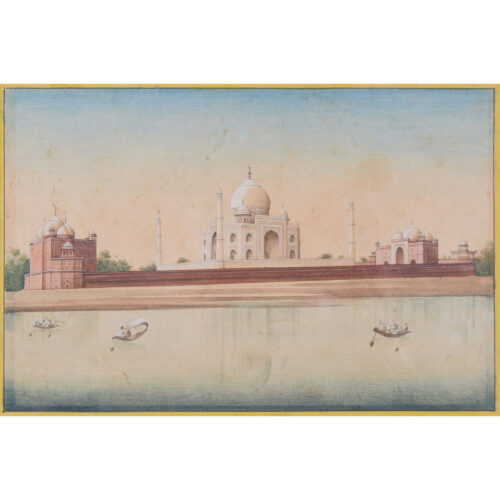
Taj Mahal, India
Watercolour 13 x 20 cmA 20th century watercolour by an unknown artist of the Taj Mahal, Shah Jahan's 1631 mausoleum for his wife. We have three other Indian architectural views by the same artist available.Condition: generally very good; one or two small scratches as visible in photographs. If you are interested, please email info@manningfineart.co.uk or call us on 07929 749056. Click here for other works from the same series. -
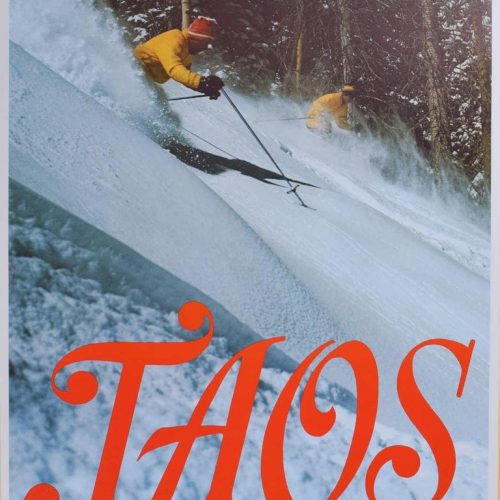
Taos New Mexico USA Vintage Ski Poster 1974 Victor Frohlich and Tom Carrera
67 x 53 cm Poster Printed by LooArt Press, Colorado Springs, Colorado Direct from the surplus stock of the printers, LooArt Press, which closed in the early 1970s. This features Victor Frohlich in the foreground, who had been at Taos Ski Valley since the start, with Tom Carrera in behind him. This is on the Snakedance fun in 1974. Taos Ski Valley was founded in 1955 by Ernie and Rhonda Blake who lived in an eleven foot camper van prior to the construction of the Hondo Lodge - now the Inn at Snakedance (where they lived without power until 1963!) In 1956 Ernie - together with sixteen men from Taos Puelbo and a mule named Lightning - installed the first lift, the Bridger-Boseman J-Bar, serving the current Snakedance run which at the time was the mountain's only run. Condition: From the printer's surplus stock, in generally excellent condition. -
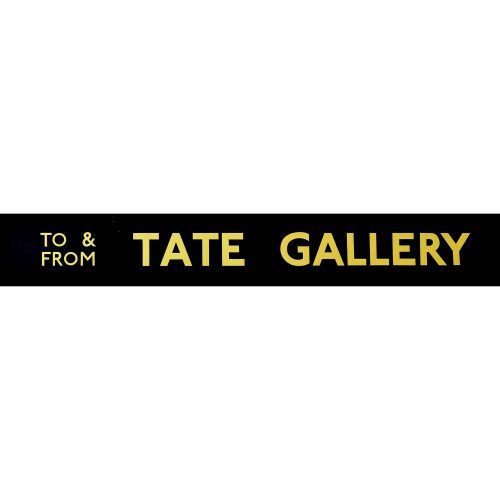
Anon.
Tate Gallery Routemaster
Slipboard Poster c.1970 Screenprint poster 64x9cm In a black hand-finished frame. Printed for London Transport for use on Routemaster or RT busses. If you are interested email info@manningfineart.co.uk or call us on 07929 749056. Condition: Excellent. -
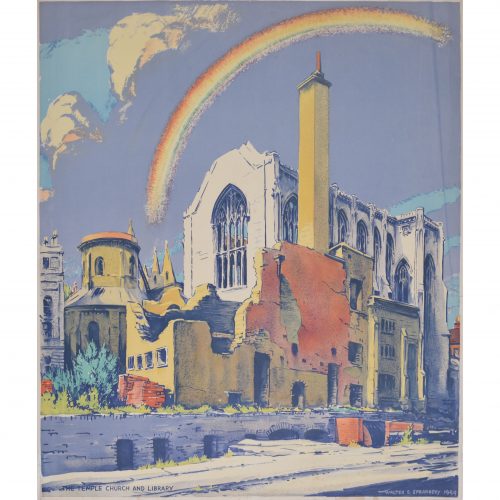
Walter Ernest Spradbery (1889 - 1969)
Temple Church and Library after Bombardment (1944)
Lithograph 66 x 57 cm Walter Spradbery's poster for the London Underground depicting a bombed Temple Church; a rainbow strikes hopefully out of the church's remains, and the sun shines on the golden stone of the building. The full poster bears the legend 'The Proud City' above Spradbery's design, and, beneath it, a quote from Charles Lamb: 'So may the winged horse, your ancient badge and cognisance, still flourish!'. This is a fantastic piece of British and London history, as well as a fantastically designed poster by a notable 20th century artist. The London Transport Museum has a copy of the poster, reference 1983/4/5751. 'The Proud City' was a series of six posters, all designed by Spradbery. They were commissioned by London Transport in 1944 as a defiant celebration of London's surviving the Blitz, and each poster also included a literary quotation. Walter Ernest Spradbery was a designer, painter, and poet who lived through the First and Second World Wars. He produced posters for LNER, Southern Railways, and London Transport, and was noted for his fascination with architecture and landscape. He studied, and later taught, at the Walthamstow School of Art. He was a pacifist and campaigned for nuclear disarmament, serving in the Medical Corps during the First World War and painting scenes of warfare for its duration, as well as during the Second World War. His anti-war stance and the horrors he had witnessed as a medic fed into his post-war poster design, especially 'The Proud City' poster series. Condition: generally very good. If you’d like to know more, please email info@manningfineart.co.uk or call us on 07929 749056. -
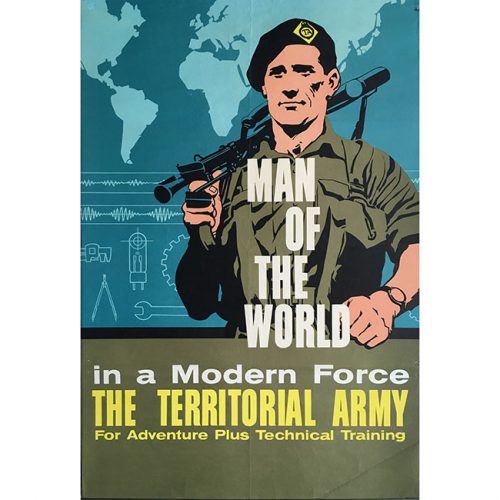
Anonymous
Man of the World: in a modern force the territorial army for adventure plus technical training
Lithographic poster c. 1960 75.5x51cm If you are interested email info@manningfineart.co.uk or call us on 07929 749056. -
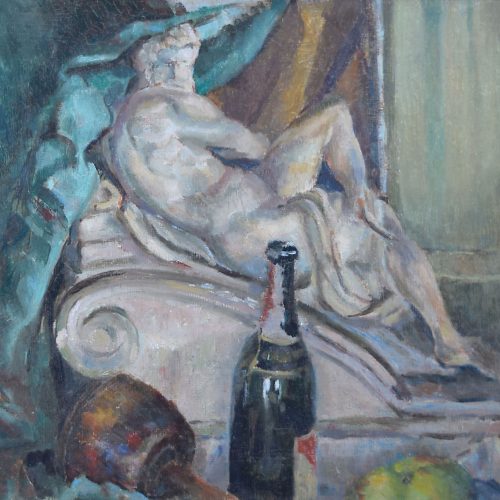 Sir Terry Frost (1915-2003) Bottle and Statue Oil on board c. 1947 38 x 46cm A distinctive still life featuring bottle, statue, and drapery. Terry Frost was a prominent British abstract artist. Frost is most noted for his simplistic abstract forms and unusual colour; he worked alongside the St Ives group and as Barbara Hepworth's assistant for several years, his artistic style being heavily influenced by them. In 1992 he became a Royal Academician, and he was made Sir Terry Frost in 1998. Bottle and Statue highlights Frost's unique compositional skill. His brushwork makes the statue seem like a real nude, who, framed by turquoise and ochre draperies, examines the still life in the foreground. An early work, painted shortly after the War and prior to his adoption of abstraction. For other works by Frost and biographical details please click here. Condition: A little craquelure in the oil above the statue's head.
Sir Terry Frost (1915-2003) Bottle and Statue Oil on board c. 1947 38 x 46cm A distinctive still life featuring bottle, statue, and drapery. Terry Frost was a prominent British abstract artist. Frost is most noted for his simplistic abstract forms and unusual colour; he worked alongside the St Ives group and as Barbara Hepworth's assistant for several years, his artistic style being heavily influenced by them. In 1992 he became a Royal Academician, and he was made Sir Terry Frost in 1998. Bottle and Statue highlights Frost's unique compositional skill. His brushwork makes the statue seem like a real nude, who, framed by turquoise and ochre draperies, examines the still life in the foreground. An early work, painted shortly after the War and prior to his adoption of abstraction. For other works by Frost and biographical details please click here. Condition: A little craquelure in the oil above the statue's head. -

Terry Frost (1915-2003)
Autumnal Landscape in Red, Black and Yellow
Watercolour 40 x 58 cm Signed and dated 1958 Framed in hand-finished grey 'Nicholson' butt-jointed frame. Click here for biographical details and other works by the artist. If you are interested email info@manningfineart.co.uk or call us on 07929 749056. In 1954 Frost moved to Leeds to become Gregory Fellow at the University. This began a period when he painted yellow and black and white paintings, inspired by the Yorkshire landscape. In 1958 he joined the London group and then moved to St Ives. This painting dates to this era. -
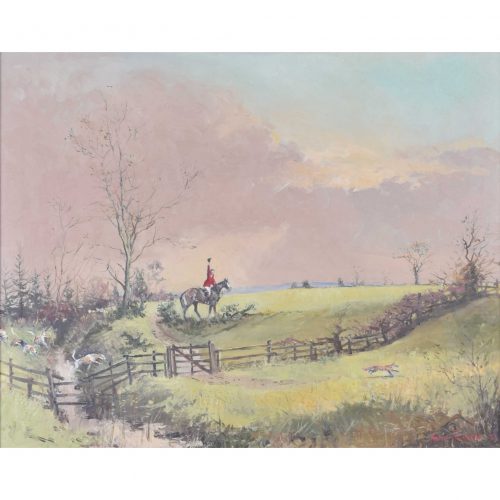
Robin Furness (born 1933)
The Three O'Clock Fox - Dobinson's Covert (1972)
Oil on canvas 40 x 50 cm Signed lower right. A delightful oil painting of the Raby Hunt at Bedburn by Robin Furness, former MFH of the Bedale Hunt and noted painter of hunting scenes. Condition: very good. If you’d like to know more, please email info@manningfineart.co.uk or call us on 07929 749056. -
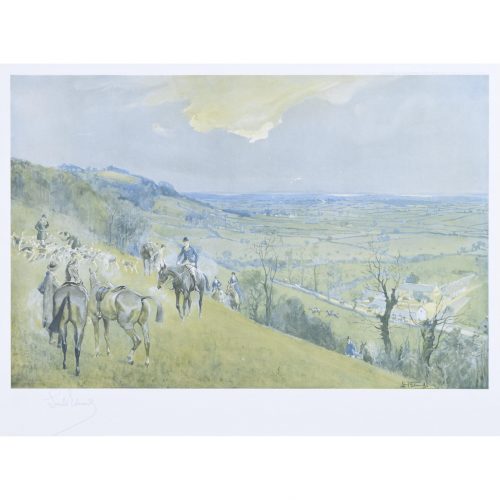
Lionel Edwards (1878 - 1966)
The Beaufort Hunt. Kill Above Sodbury Vale. (1925)
Lithograph 38 x 52 cm Signed in plate lower right and in pencil lower left outside the plate. Printed and Published by Eyre and Spottiswoode. A Lionel Edwards lithograph depicting the Beaufort - part of the artist's 1925 'Hunting Countries' series. The Beaufort's hunt dress is peculiar to the country in that the Huntsman and Whippers-In wear green and the subscribers a blue coat with buff facings. The earliest records of hounds being kennelled at Badminton date back to 1640 when the then Marquis of Worcester hunted mainly deer, but hare and fox as well. Dukes of Beaufort have either hunted hounds themselves or have been in the Mastership since the title was created in 1682 and the hounds, kennels and stables still belong to them. The 10th Duke was master from 1924 to 1984 and so great was his contribution to foxhunting he became universally known as "Master". The Beaufort is one of the few remaining private packs. Lionel Edwards was a British artist who specialised in pictures of country life, particularly horses, and provided illustrations for Country Life. He is best known for his hunting scenes but also painted pictures of horse racing, shooting and fishing. Condition: generally very good; some fading to the clouds. If you are interested, please email info@manningfineart.co.uk or call us on 07929 749056. Click here for other hunting pictures. -
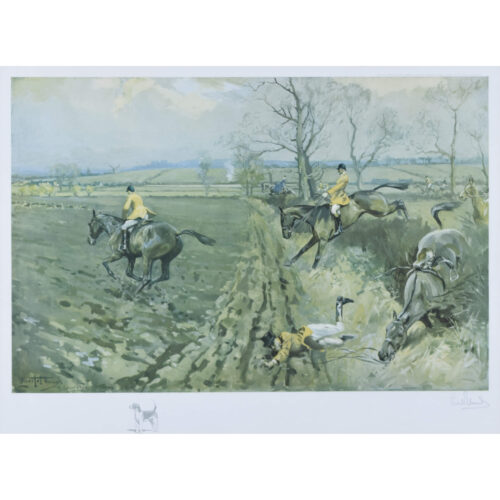
Lionel Edwards (1878 - 1966)
The Belvoir Hunt (1928)
Lithograph 31 x 51 cm Signed and dated in plate lower left, and in pencil outside plate lower left. A Lionel Edwards lithograph depicting the Belvoir - part of the artist's 'Hunting Countries' series. The Belvoir Hunt, sometimes known as the Duke of Rutland's Hounds, dates from 1750 and became a foxhound pack in 1762. Since then, the kennels have been located at Belvoir Castle. Lionel Edwards was a British artist who specialised in pictures of country life, particularly horses, and provided illustrations for Country Life. He is best known for his hunting scenes but also painted pictures of horse racing, shooting and fishing. Condition: print good; original handsome period frame; small area of loss to top of frame. If you are interested, please email info@manningfineart.co.uk or call us on 07929 749056. Click here for other hunting pictures. -
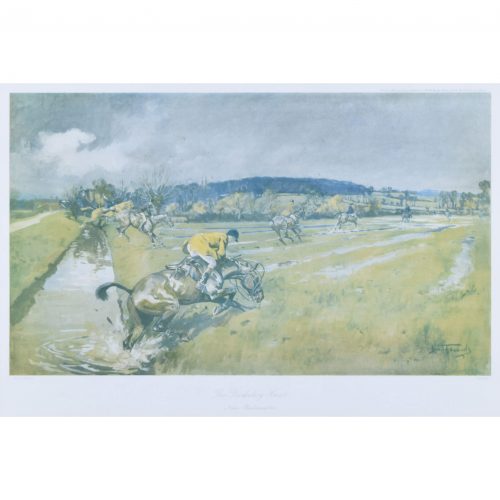
Lionel Edwards (1878 - 1966)
The Berkeley Hunt - Near Rockhampton (1925)
Lithograph 34 x 51 cm Signed in plate lower right. In original 3/4" black frame. A Lionel Edwards lithograph depicting the Berkeley - part of the artist's 1925 'Hunting Countries' series. The yellow coats with green collars and the running fox on the lapel are worn by the Masters and Hunt Staff and are unique in hunting circles, representing the outdoor livery of the Berkeley family; the ladies' colours of navy and maroon represent the indoor livery. The Berkeley is the oldest pack in the country and is one of the very few that are still family owned. The Fifth Earl of Berkeley could hunt his hounds from Berkeley Castle to Berkeley Square in London and had six kennels along the route. The season would start in Berkeley and progress to each of his kennels to London and then in stages back again to Gloucestershire. The present kennels date from the early 18th century and are home to around 90 hounds. Lionel Edwards was a British artist who specialised in pictures of country life, particularly horses, and provided illustrations for Country Life. He is best known for his hunting scenes but also painted pictures of horse racing, shooting and fishing. Condition: print generally good; the odd tiny spot in top left area. In original 3/4" black frame - some scratches to frame. If you are interested, please email info@manningfineart.co.uk or call us on 07929 749056. Click here for other hunting pictures. -
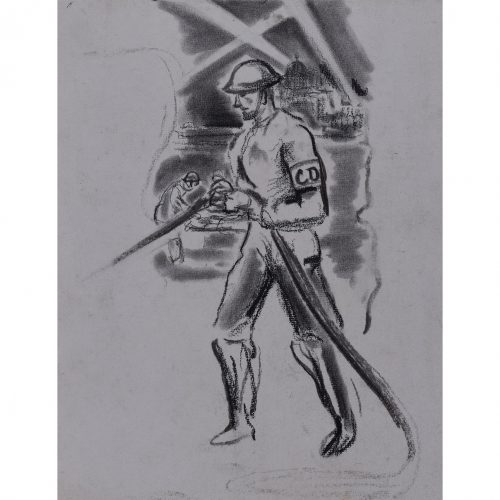
The Blitz: A Civil Defence Firefighter In Action before St Paul's Cathedral with Search Lights and Stretcher Bearers
Charcoal c. 1940 30x24cm A World War II Civil Defence firefighter, with 'CD' armband operates a fire hose as stretcher bearers work behind him, St Paul's cathedral being illuminated by searchlights. A typical night-time scene from London during the 1940 Blitz. If you are interested email info@manningfineart.co.uk or call us on 07929 749056. -
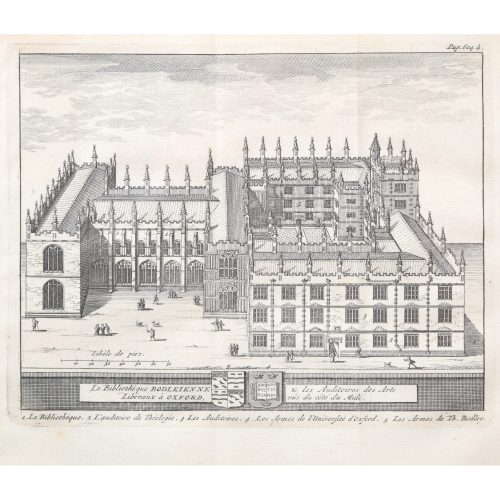
Pieter van der Aa (1659-1733), after David Loggan (1634–1692)
The Bodleian Library, Oxford (1727)
Engraving 12 x 16 cm An eighteenth-century view of the beautiful Bodleian Library, engraved by Pieter van der Aa after David Loggan, the noted engraver, draughtsman, and painter. Pieter van der Aa of Leiden was a Dutch publisher best known for preparing maps and atlases, though he also printed editions of foreign bestsellers and illustrated volumes. He is noted for the many engravings he produced after David Loggan's series of Oxford and Cambridge colleges and costumes. In 1727 Van Der Aa illustrated "Les Delices de la Grande Bretagne & de L'Irelande" by James Beeverell, the book in which this engraving appears. Condition: a good impression. If you’d like to know more, please email info@manningfineart.co.uk or call us on 07929 749056. -
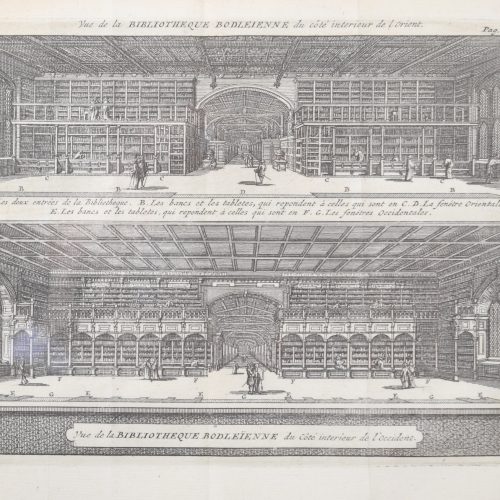
Pieter van der Aa (1659-1733), after David Loggan (1634–1692)
The Bodleian Library, University of Oxford
Engraving (1727) 12 x 16 cm An eighteenth-century view of the interior of the Bodleian Library, engraved by Pieter van der Aa after David Loggan, the noted engraver, draughtsman, and painter. Pieter van der Aa of Leiden was a Dutch publisher best known for preparing maps and atlases, though he also printed editions of foreign bestsellers and illustrated volumes. He is noted for the many engravings he produced after David Loggan's series of Oxford and Cambridge colleges and costumes. In 1727 Van Der Aa illustrated "Les Delices de la Grande Bretagne & de L'Irelande" by James Beeverell, the book in which this engraving appears. Condition: a good impression. If you are interested, please email info@manningfineart.co.uk or call us on 07929 749056. -

Colin Moss (1914 - 2005)
The Cedars, Kensington
Watercolour and gouache 57 x 40 cm Signed and dated '50 lower right. Moss' view of the Cedars, complete with passers-by and a stormy, jagged sky. Colin Moss was a noted British painter, draughtsman, printmaker, and teacher who served as a camoufleur during the Second World War. Moss was born in Ipswich but grew up in Plymouth following the death of his father at the Battle of Passchendaele in 1917. Moss studied at the Plymouth Art School from 1930 to 1934 and then went on to the Royal College of Art, where he studied under Gilbert Spencer and Charles Mahoney. He worked on murals for the British Pavilion at the 1939 New York World's Fair. During the war, Moss made a series of watercolours depicting his time as a camoufleur. He had designed the camouflage scheme for Stonebridge Power Station in Wembley, and produced several watercolours of the camouflaged structure. These pictures, as well as several others painted during his WWII deployment, are now held by the Imperial War Museum, having been purchased by the War Artists' Advisory Committee. In 1947 Moss' military service ended, and he became a teacher at the Ipswich School of Art. He had solo exhibitions at the Kensington Art Gallery in 1951 and the Zwemmer Gallery in 1955, and his work began to be acquired by the national collections. He became a founder member of the New Ipswich Art Group in 1958, and the Six in Suffolk Group in 1976. In the 1970s he exhibited at the Royal Academy and the Royal Watercolour Society, and retrospective exhibitions of his work were held at various British art galleries throughout the 1980s. He continued to hold numerous solo exhibitions after his retirement, and taught artists Brian Eno and Maggi Hambling. Provenance: "Britain in Watercolours" exhibition. Condition: excellent. If you’d like to know more, please email info@manningfineart.co.uk or call us on 07929 749056. -

J Black (early 19th century) after Frederick Mackenzie (1788 - 1854)
The Choir, Westminster Abbey (1812)
Hand-coloured aquatint 28 x 19 cm Published by Rudolph Ackermann (1764 - 1834). An engraving of the vast and soaring interior of Westminster Abbey. Mackenzie's drawing was engraved by Black and published by Ackermann in his 1812 "History of Westminster Abbey". The Abbey is an historic, mainly Gothic church in the City of Westminster, London, just to the west of the Palace of Westminster. It is one of the United Kingdom's most notable religious buildings and since Edward the Confessor, a burial site for English and, later, British monarchs. Since the coronation of William the Conqueror in 1066, all coronations of English and British monarchs have occurred in Westminster Abbey. Sixteen royal weddings have occurred at the abbey since 1100. According to a tradition first reported circa 1080, a church was founded at the site (then known as Thorney Island) in the seventh century, in the time of Mellitus, Bishop of London. Construction of the present church began in 1245 on the orders of Henry III. Frederick Mackenzie (1788 - 1854) was a British watercolourist and architectural draughtsman. He first exhibited at the Royal Academy in 1804, and contributed eleven drawings between that year and 1828. He contributed to the Society of Painters in Water Colours exhibitions from 1813, becoming an associate in 1822, and a full member the following year. From 30 November 1831 till his death he was treasurer to the society. In later life Mackenzie was no longer commissioned to illustrate books. Rudolph Ackermann was an Anglo-German bookseller, inventor, lithographer, publisher and businessman. In 1795 he established a print-shop and drawing-school at 96 Strand. Here Ackermann set up a lithographic press and began a trade in prints. He later began to manufacture colours and thick carton paper for landscape and miniature painters. Within three years the premises had become too small and he moved to 101 Strand, in his own words "four doors nearer to Somerset House", the seat of the Royal Academy of Arts. Between 1797 and 1800 Ackermann rapidly developed his print and book publishing business, encompassing many different genres including topography, caricature, portraits, transparencies and decorative prints. Condition: good. Some age toning. If you’d like to know more, please email info@manningfineart.co.uk or call us on 07929 749056. -
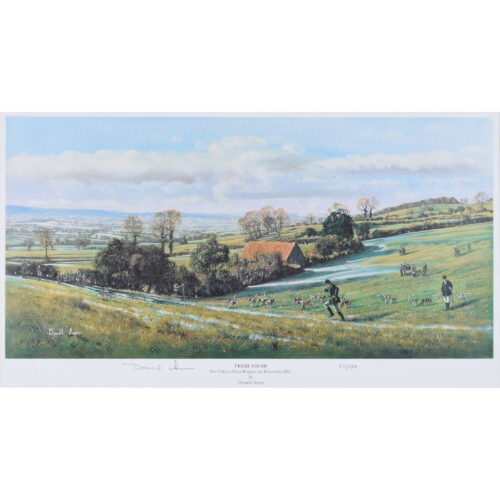
Donald Ayres (b. 1936)
The Clifton Foot Beagles on Butcombe Hill
Lithograph 24 x 44 cm Signed and numbered 423/500. A lithograph of the Clifton Foot Beagles, now the Chilmark and Clifton Foot Beagles. Donald Ayres is a landscape painter specialising in country sports such as hunting, shooting, and fishing. His work has been exhibited in most of the major commercial galleries in Britain, as well as many in Europe and America. Condition: very good. If you are interested, please email info@manningfineart.co.uk or call us on 07929 749056. Click here for other hunting pictures. -
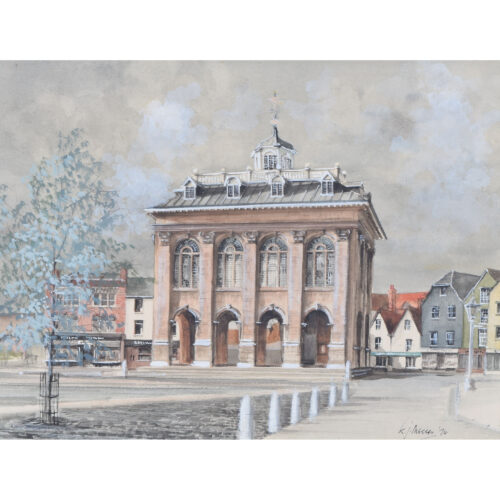
Ken Messer (1931 - 2018)
The County Hall, Abingdon (1974)
Watercolour 24 x 32 cm Signed and dated lower right. The painter and draughtsman Ken Messer is closely related to Oxford and its architecture in several ways. Born in Newport, South Wales, he was educated at the City of Oxford High School for Boys in Oxford, and then spent six years working as an accountant in Oxford. He then joined British Overseas Airways Corporation (BOAC) as a steward, flying internationally. Injury due to a car accident during the 1960s meant that he joined the design department of Pergamon Press in Oxford at the age of 33. Six years later, he was appointed to the position of studio manager, in charge of art and design. In 1974, Messer left Pergamon Press to become a freelance graphic designer. He started painting more watercolours, becoming a full-time artist. During the 1980s, his ink drawings were regularly published in the Oxford Times. He has sometimes been called "The Oxford Artist" because of his large number of works depicting Oxford. He and his wife Dilys lived at first in Richmond upon Thames and then in Abingdon, just south of Oxford. Messer's work has been shown at the Mall Galleries for the annual exhibitions of the Royal Institute of Painters in Water Colours annual exhibitions. Condition: very good. If you are interested, please email info@manningfineart.co.uk or call us on 07929 749056. -
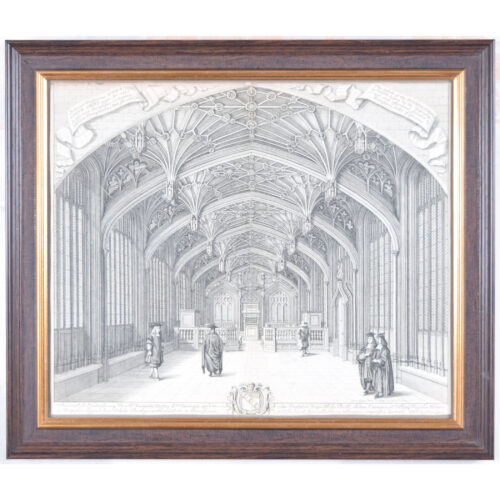
David Loggan (1634 - 1692)
The Divinity School, Oxford (1675)
Engraving 33 x 41 cm David Loggan's view of Oxford's medieval Divinity School, which was once the beating heart of theological studies at the University. Of particular interest here is the trompe l'oeil scroll of torn paper which frames the view. Loggan was born to English and Scottish parents, and was baptised in Danzig in 1634. After studying engraving in Danzig with Willem Hondius (1598-1652 or 1658), he moved to London in the late 1650s, going on to produce the engraved title-page for the folio 1662 Book of Common Prayer. He married in 1663 and moved to Nuffield in Oxfordshire in 1665. Loggan was appointed Public Sculptor to the nearby University of Oxford in the late 1660s, having been commissioned to produce bird’s-eye views of all the Oxford colleges. He lived in Holywell Street as he did this. The 'Oxonia Illustrata' was published in 1675, with the help of Robert White (1645-1704). Following its completion, Loggan began work on his equivalent work for Cambridge; the 'Cantabrigia Illustrata' was finally published in 1690, when he was made engraver to Cambridge University. The 'Oxonia Illustrata' also includes an engraving of Winchester College (Winchester and New College share William of Wykeham as their founder) whilst the 'Cantabrigia Illustrata' includes one of Eton College (which shares its founder, Henry VIII, with King’s College). Bird’s-eye views from this era required a particular talent as an architectural perspectivist; it was not until 1783 that it became possible for artists to ascend via hot air balloons and view the scenes they were depicting from above. Loggan thus had to rely on his imagination in conceiving the views. Loggan’s views constitute the first accurate depictions of the two Universities, in many ways unchanged today. Whilst the Oxford engravings were produced in reasonable numbers and ran to a second edition by Henry Overton (on thicker paper and with a plate number in Roman numerals in the bottom right-hand corner), those of Cambridge were printed in much smaller numbers. The Dutchman Pieter van der Aa published some miniature versions of the engravings for James Beverell’s guidebook to the UK, 'Les Delices de la Grande Bretagne' (circa 1708). The contemporary artist Andrew Ingamells (born 1956) has produced a highly-acclaimed series of etchings which bring Loggan’s original vision up to date. Condition: trimmed within platemark and mounted to board, otherwise in very good condition. If you are interested, please email info@manningfineart.co.uk or call us on 07929 749056. Click here for other general views of Oxford. -
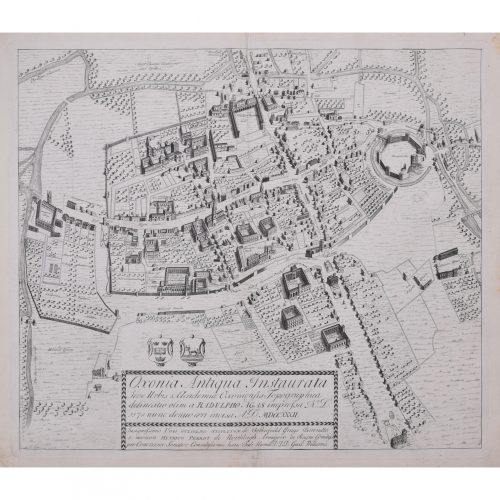
William Williams (Welsh, active 1724 - 1733)
The First Map of Oxford (1733)
Engraving 47 x 54 cm In 1578, Ralph Agas drew the first ever map of Oxford, studded with the first colleges of the University. In 1733 it was engraved by William Williams for publication in the Oxonia Depicta, a book of illustrations depicting similar views as David Loggan's volume of engravings. Ralph Agas was an English surveyor and cartographer. He was born in Suffolk and lived there throughout his life, although he travelled regularly to London. He began to practise as a surveyor in about 1566, and has been described as "one of the leaders of the emerging body of skilled land surveyors". regular work consisted of drawing up local estate maps and surveys for a variety of clients. He was one of the first estate surveyors to move beyond the traditional practice of compiling purely written descriptions of landed property, and to supplementing them with measured maps. Condition: generally very good; a few marks to margins. Central fold as issued. If you’d like to know more, please email info@manningfineart.co.uk or call us on 07929 749056. Click here for other general views of Oxford. -
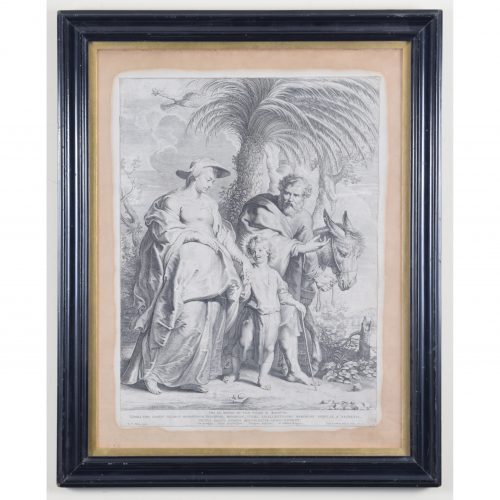
Lucas Vorsterman (1595 - 1675) after Peter Paul Rubens (1577 - 1640)
The Flight into Egypt (1620)
Engraving 30 x 45 cm Rare. We have only been able to trace one copy at auction, 2019, Izegem, Belgium. A copy of this print is held by the British Museum (R,3.50). Mary, Joseph, and the infant Christ escape into Egypt on a donkey. Lucas Vorsterman was a Baroque engraver. He worked with the artists Peter Paul Rubens and Anthony van Dyck, as well as for patrons such as Thomas Howard, 21st Earl of Arundel and Charles I of England. Condition: mounted to old paper; trimmed to platemarks; two areas of repair in region of Mary's left hand and Christ's right knee (see photo). In old ebonised frame. If you are interested, please email info@manningfineart.co.uk or call us on 07929 749056. -
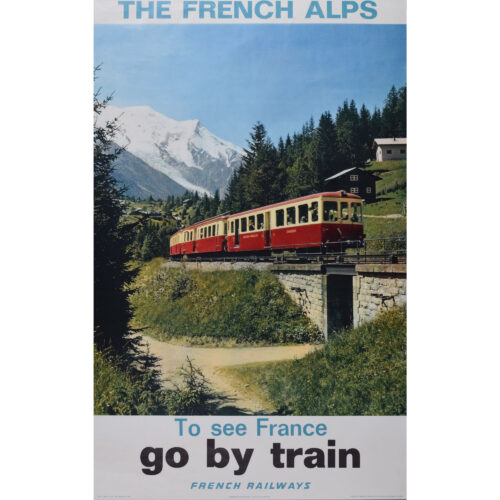
The French Alps - To See France, Go by Train (1966)
Original vintage poster 100 x 66 cm This French Railways poster encourages tourism to the French Alps, where the railway views are (and always have been) particularly charming. Condition: generally very good. If you are interested, please email info@manningfineart.co.uk or call us on 07929 749056. Click here for other original vintage travel posters. -
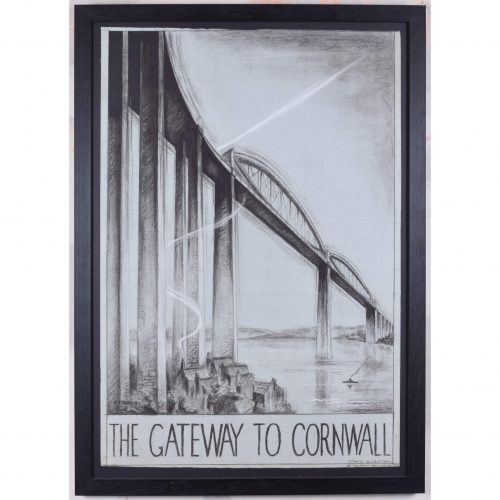
Ronald T Horley (active 1930s - 1940s)
The Gateway to Cornwall
Charcoal heightened with white 76 x 53 cm Signed and inscribed lower right 'Architect's Office, 83 Marlborough Place NW8 Marylebone'. The Great Western Railway commissioned a series of posters promoting train travel around the UK. This charcoal drawing of the Royal Albert Bridge at Saltash is the artist's original design for a poster encouraging rail travel to Devon and Cornwall. The bridge is known fondly as the 'Gateway to Cornwall'. The Royal Albert Bridge was designed by Isambard Kingdom Brunel. Surveying started in 1848 and construction commenced in 1854. The first main span was positioned in 1857 and the completed bridge was opened by Prince Albert on 2 May 1859. Condition: generally very good; a few isolated spots to bottom left corner. Click here for other original vintage travel posters and designs. -
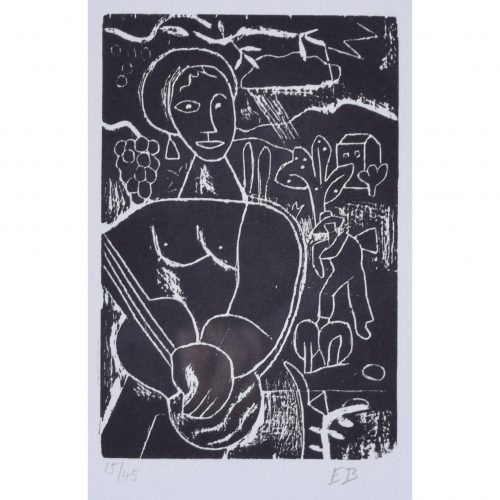
Edward Burra (1905 - 1976)
The Guitar Player
(1928 - 1929, this edition published 1971) Woodcut 15 x 10 cm; sheet size 34 x 24 cm Numbered 15/45 lower left and initialled EB lower right. Burra's woodcut of a female guitar player surrounded by a landscape of cacti. A bunch of grapes is pendent beside her triangular earring, and a male figure in a wide-brimmed hats stands in the field nearby. Edward Burra was an English painter, draughtsman, and printmaker. He travelled to Italy in 1925, the same year he met the noted British Surrealist Paul Nash, and both of these influences are evident in this woodcut. Nash introduced Burra to woodcut-making in 1928, the same year that Burra began this woodcut series. His first solo show was held at the Leicester Galleries in April 1929, and he exhibited with the English Surrealists in the 1930s. Condition: Excellent. If you’d like to know more, please email info@manningfineart.co.uk or call us on 07929 749056. -

Lionel Edwards (1878 - 1966)
The Hertfordshire Hunt (1927)
Lithograph 36 x 50 cm Signed and dated in plate lower left. A Lionel Edwards lithograph depicting the Hertfordshire - part of the artist's 'Hunting Countries' series. The Hertfordshire Hunt was founded circa 1775 by the Countess of Salisbury, of Hatfield House. Lionel Edwards was a British artist who specialised in pictures of country life, particularly horses, and provided illustrations for Country Life. He is best known for his hunting scenes but also painted pictures of horse racing, shooting and fishing. Condition: print generally good; a couple of tiny scuffs to surface. Modern frame. If you are interested, please email info@manningfineart.co.uk or call us on 07929 749056. Click here for other hunting pictures. -
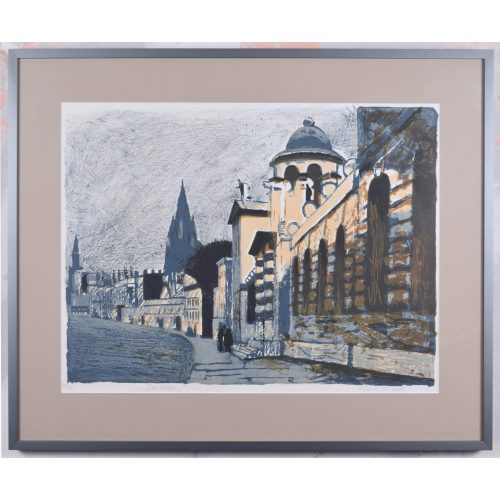
Edwin La Dell (1914-1970)
The High, Oxford
Lithograph 49 x 64 cm Signed, titled, and number 28/80 in pencil. A beautiful depiction of the golden Headington stone of Queen's College on the High Street, Oxford. The cupola above the college's entrance, and, in the background, the shadowy spire of the University Church of St Mary the Virgin, rise into the blustery sky. La Dell studied at the Sheffield School of Art, where he won a scholarship to the Royal College of Art. From 1934 to 1940 John Nash was the head of printmaking there, and taught La Dell. La Dell himself became head of lithography there in 1948, and remained in post until his death. During the war La Dell was an official war artist and a camofleur, but he is probably best known for his lithographs of Oxford and Cambridge that he published himself. His works are widely held in the public collections, including the Royal Academy and the Government Art Collection, the latter of which holds many of his views of Cambridge. Condition: very good. If you are interested, please email info@manningfineart.co.uk or call us on 07929 749056. Click here for other views of Queen's College, Oxford. -
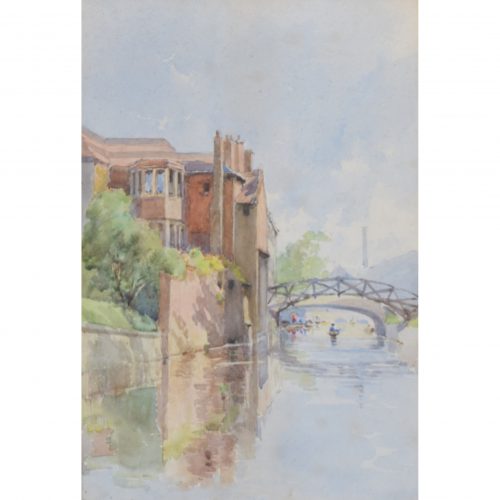
The Mathematical Bridge, Queens' College, Cambridge
Watercolour 27 x 18 cm A delightful watercolour of Cambridge's famous Mathematical Bridge. Figures punt under the bridge and the buildings of Queens are reflected in the serene waters of the River Cam. Kate Hillman of the Cambridge University Engineering Department notes that: "One of the most recognisable structures on the Cam, Queens' College bridge was originally built in 1749 by James Essex the Younger. Since then it has been rebuilt twice to the original design of William Etheridge, once in 1866 and again in 1905. In 1866 the bridge deck was changed from a stepped design to the current sloped deck. In 1905 a complete rebuild of the bridge was required due to weathering of the original oak structure. stories have suggested that a group of students (or professors, depending on the storyteller) disassembled the bridge to discover how it stood up and then couldn't put it back together. The bridge was supposedly then rebuilt using rather prominent bolts." Condition: very good; gilt frame has some age. If you’d like to know more, please email info@manningfineart.co.uk or call us on 07929 749056. -

John Appleyard (1908 - 1960)
The Middleton Hunt at Sherriff Hutton
Watercolour 28 x 37 cm Signed lower right. The Huntsman and hounds of North Yorkshire's Middleton Hunt. Condition: very good. If you’d like to know more, please email info@manningfineart.co.uk or call us on 07929 749056. -
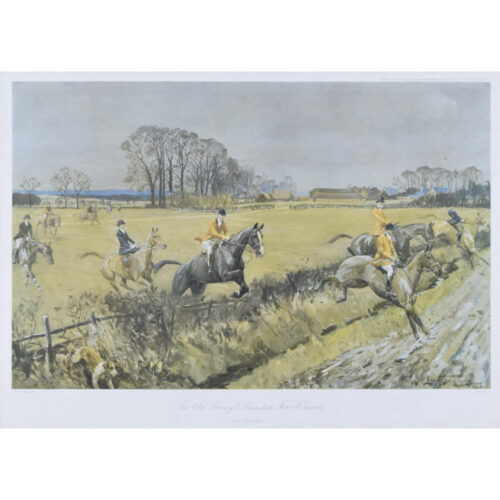
Lionel Edwards (1878 - 1966)
The Old Surrey and Burstow Fox Hounds - at Burstow (1926)
Lithograph 36 x 51 cm Signed and dated in plate lower right. In original 3/4" black frame. A Lionel Edwards lithograph depicting the Old Surrey and Burstow - part of the artist's 'Hunting Countries' series. The Old Surrey and Burstow (now the Old Surrey, Burstow and West Kent Hunt) has been hunting from Felbridge since 1909. The Burstow dates as a foxhound pack from 1866, having previously existed as a harrier pack. Lionel Edwards was a British artist who specialised in pictures of country life, particularly horses, and provided illustrations for Country Life. He is best known for his hunting scenes but also painted pictures of horse racing, shooting and fishing. Condition: print generally good; the odd tiny spot in top right corner. In original 3/4" black frame; some scratches to frame. If you are interested, please email info@manningfineart.co.uk or call us on 07929 749056. Click here for other hunting pictures. -
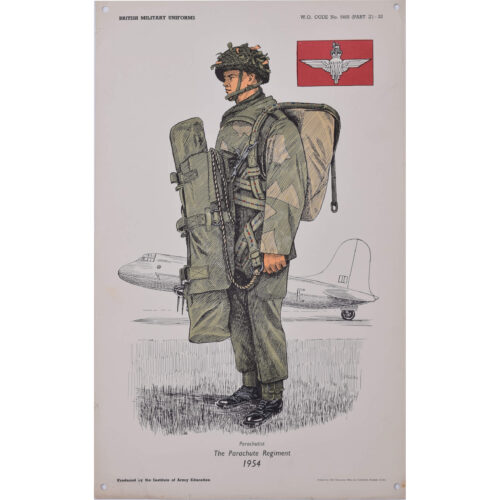
The Parachute Regiment Parachutist 1954 uniform
Lithograph 50 x 31 cm Produced for the Institute of Army Education. Printed for HM Stationery Office by I A Limited, Southall 51. These posters were produced by the Institute of Army Education, likely for display in barracks. Created in the 1950s, they illustrate the 'vintage' uniforms worn by the Corps during the First World War. Condition: punched holes to corners as issued; otherwise generally very good. If you are interested, please email info@manningfineart.co.uk or call us on 07929 749056. Click here for other original vintage Institute of Army Education uniform posters. -
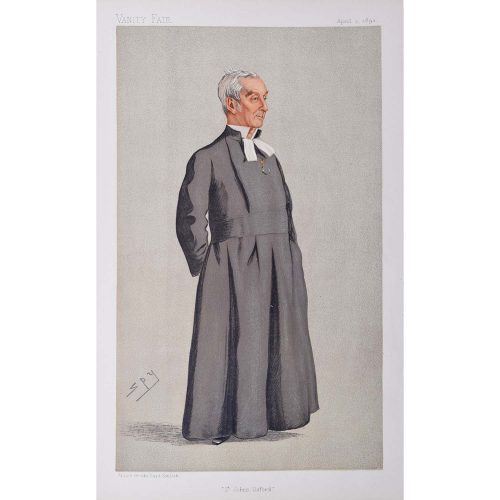
Vanity Fair Spy Magazine President of St john's College Oxford
1 April 1893 Lithograph If you are interested email info@manningfineart.co.uk or call us on 07929 749056. Condition: Good. -
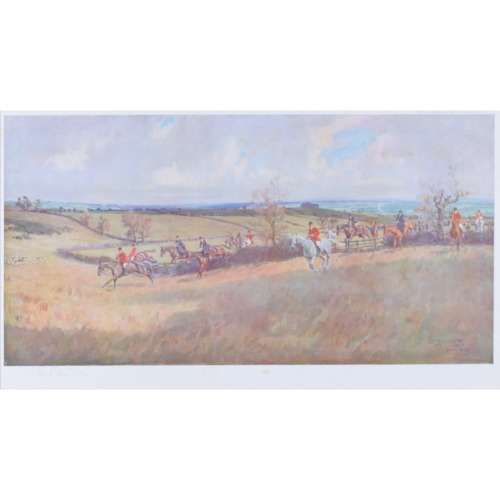
Lionel Edwards (1878 - 1966)
The Quorn Hunt (1934)
Lithograph 34 x 62 cm Signed, titled and dated in plate lower right. Signed in pencil outside plate lower left. A Lionel Edwards lithograph depicting the Quorn - part of the artist's 'Hunting Countries' series. The Quorn Hunt has a claim to be the oldest hunt in the country, being founded in 1696 by Mr Thomas Boothby of Tooley Park, Leicestershire. The hunt takes its name from the village of Quorn, where the hounds were kennelled from 1753 to 1904. Lionel Edwards was a British artist who specialised in pictures of country life, particularly horses, and provided illustrations for Country Life. He is best known for his hunting scenes but also painted pictures of horse racing, shooting and fishing. Condition: print generally good; a couple of very small brown spots. Original 3/4" black frame in generally good condition. If you are interested, please email info@manningfineart.co.uk or call us on 07929 749056. Click here for other hunting pictures. -
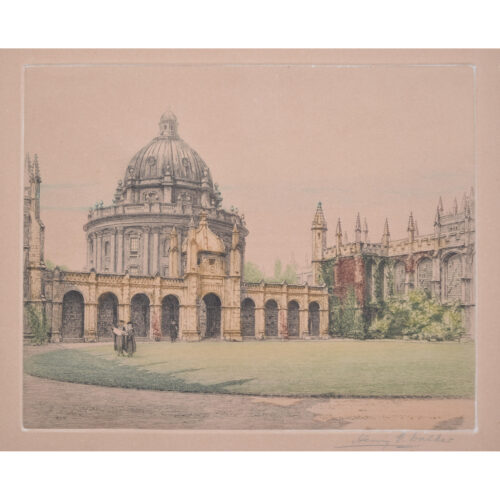
Henry George Walker (1876 - 1932)
The Radcliffe Camera from All Souls College, Oxford
Etching 20 x 25 cm Signed lower right in pencil. The artist depicts the North Quadrangle of All Souls, with the Radcliffe Camera peeking in. Two fellows contemplate a document as a third approaches. Henry Walker was born in Birmingham and specialised in architectural and landscape etchings. Condition: generally very good. If you’d like to know more, please email info@manningfineart.co.uk or call us on 07929 749056. Click here for other views of All Souls. -
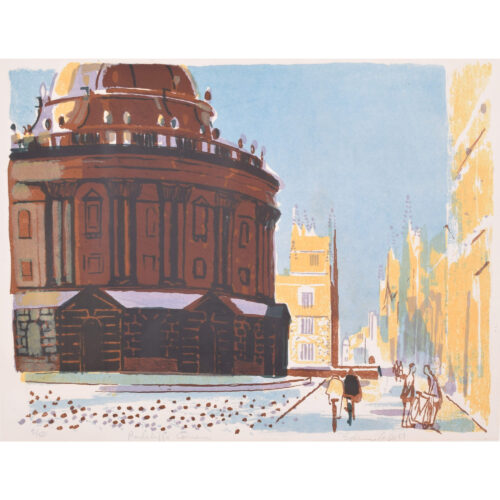
Edwin La Dell (1914-1970)
The Radcliffe Camera, Oxford
Lithograph 41 x 54 cm Numbered 2/50, titled, and signed below in pencil. Radcliffe Square in autumn shades. The Radcliffe Camera dominates the lithograph, and La Dell expertly captures the afternoon sun on the golden stone of Brasenose and the University Church. Students cycle towards the High. La Dell studied at the Sheffield School of Art, where he won a scholarship to the Royal College of Art. From 1934 to 1940 John Nash was the head of printmaking there, and taught La Dell. La Dell himself became head of lithography there in 1948, and remained in post until his death. During the war La Dell was an official war artist and a camofleur, but he is probably best known for his lithographs of Oxford and Cambridge that he published himself. His works are widely held in the public collections, including the Royal Academy and the Government Art Collection, the latter of which holds many of his views of Cambridge. Condition: generally very good. Fractional age-toning to paper; old glue marks to margin which will be under the mount when framed. If you are interested, please email info@manningfineart.co.uk or call us on 07929 749056. Click here for other general views of Oxford. -
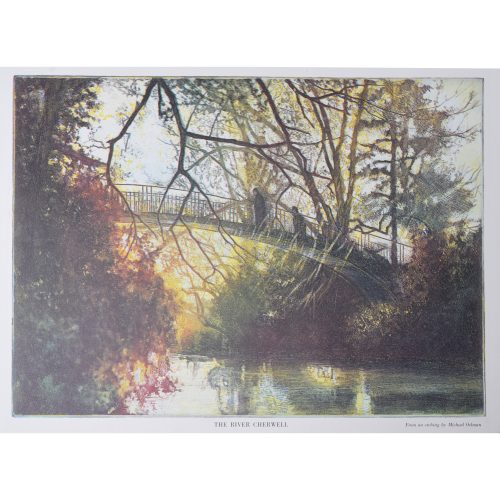
Michael Oelman (born 1941)
The River Cherwell
Lithograph 33 x 46 cm A lithograph of Oxford's wondrous River Cherwell in University Parks, from an etching by Michael Oelman. A setting sun casts its gold light over the glassy surface of the river and its surrounding trees; two figures cross the Cherwell via the famous Rainbow Bridge. The curved footbridge was built in the early 1920s by the University a project for the unemployed. Oelman's etching was reproduced as a lithograph in 1981, to be published in the "Oxford Almanack". The Oxford Almanack was an annual almanac published by the Oxford University Press for the University of Oxford from 1674 through 2019 (when printing sadly ceased due to "dwindling interest"). The almanac traditionally included engravings or lithographs of the University and information about the upcoming year. Other almanac artists have included James Basire, Michael Burghers, J. M. W. Turner, and John Piper. Michael Oelman was born in Llandudno, Wales, in 1941. He studied fine art at Reading University and then etching and lithography at the Central and Slade Schools of Art. In the 1960s he studied with S. W. Hayter in Paris, and then became a lecturer in Printmaking at Doncaster College of Art, Yorkshire. His studio is in Suffolk. Condition: very good. If you’d like to know more, please email info@manningfineart.co.uk or call us on 07929 749056. -
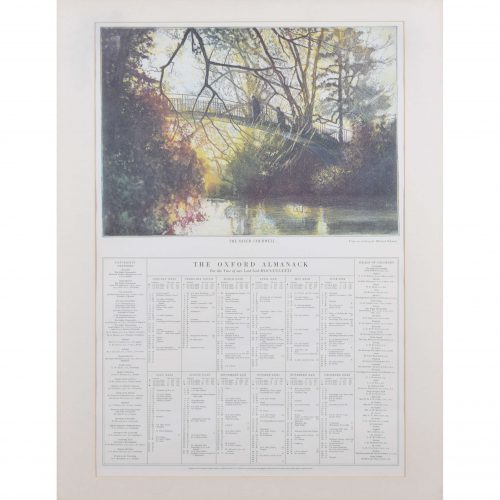
after Michael Oelman (born 1941)
The River Cherwell, The Oxford Almanac 1981
Lithograph 71 x 47 cm A lithograph featuring Oxford's wondrous River Cherwell in University Parks, after an etching by Michael Oelman. A setting sun casts its gold light over the glassy surface of the river and its surrounding trees; two figures cross the Cherwell via the famous Rainbow Bridge. The curved footbridge was built in the early 1920s by the University a project for the unemployed. Oelman's etching was reproduced as a lithograph in 1981, to be published in the "Oxford Almanack". The Oxford Almanack was an annual almanac published by the Oxford University Press for the University of Oxford from 1674 through 2019 (when printing sadly ceased due to "dwindling interest"). The almanac traditionally included engravings or lithographs of the University and information about the upcoming year. Other almanac artists have included James Basire, Michael Burghers, J. M. W. Turner, and John Piper. Michael Oelman was born in Llandudno, Wales, in 1941. He studied fine art at Reading University and then etching and lithography at the Central and Slade Schools of Art. In the 1960s he studied with S. W. Hayter in Paris, and then became a lecturer in Printmaking at Doncaster College of Art, Yorkshire. His studio is in Suffolk. Condition: very good. If you are interested, please email info@manningfineart.co.uk or call us on 07929 749056. Click here for other general views of Oxford. -
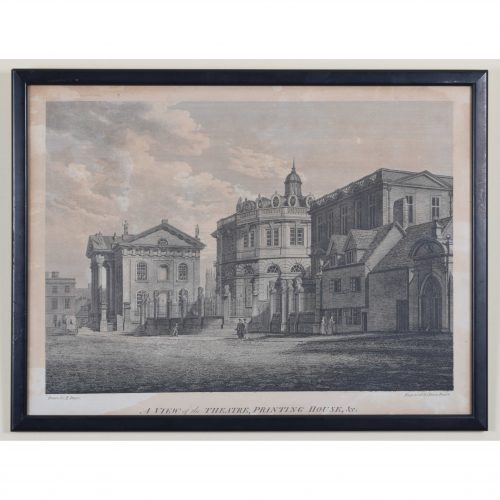
James Basire II (1769 - 1822) after Edward Dayes (1763 - 1804)
A View of the Theatre, Printing House, & c. (1800)
Engraving 36 x 49 cm A view of Broad Street, showing the Clarendon Building, Sheldonian Theatre, and what is now the Museum of the History of Science. Edward Dayes' drawing was reproduced as a lithograph in 1800, to be published in the "Oxford Almanack". The Oxford Almanack was an annual almanack published by the Oxford University Press for the University of Oxford from 1674 through 2019 (when printing sadly ceased due to "dwindling interest"). The almanack traditionally included engravings or lithographs of the University and information about the upcoming year. Other almanack artists have included Michael Burghers, J. M. W. Turner, and John Piper. Basire and Dayes collaborated on several views of Oxford during the courses of their careers. Edward Dayes was a British painter and engraver. He exhibited topographical views at the Royal Academy from 1786 until his death, and is the author of an ''Excursion through Derbyshire and Yorkshire,'' ''Essays on Painting; Instructions for Drawing and Colouring Landscapes'', and ''Professional Sketches of Modem Artists''. James Basire II was a British engraver, son of James Basire I, also a celebrated engraver. In 1802 he became Engraver to the Society of Antiquaries. Condition: some browning, as visible in photograph. If you’d like to know more, please email info@manningfineart.co.uk or call us on 07929 749056. -
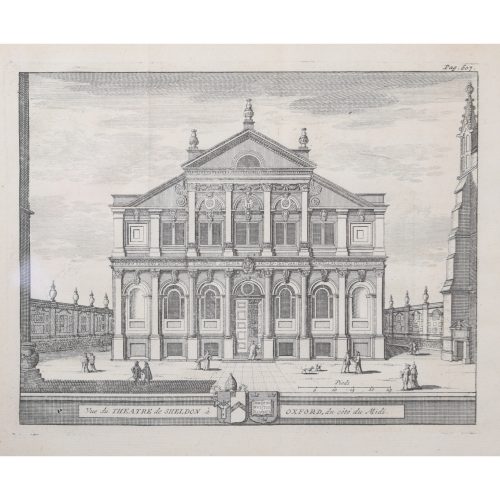
Pieter van der Aa (1659-1733), after David Loggan (1634–1692)
The Sheldonian Theatre, University of Oxford (1727)
Engraving 12 x 16 cm An eighteenth-century view of Oxford's marvellous Sheldonian Theatre, engraved by Pieter van der Aa after David Loggan, the noted engraver, draughtsman, and painter. Christopher Wren designed the building and it was constructed between 1664 and 1669; it takes its name from Gilbert Sheldon, chancellor of the University at the time and the Theatre's main financial backer. Pieter van der Aa of Leiden was a Dutch publisher best known for preparing maps and atlases, though he also printed editions of foreign bestsellers and illustrated volumes. He is noted for the many engravings he produced after David Loggan's series of Oxford and Cambridge colleges and costumes. In 1727 Van Der Aa illustrated "Les Delices de la Grande Bretagne & de L'Irelande" by James Beeverell, the book in which this engraving appears. Condition: a good impression. If you’d like to know more, please email info@manningfineart.co.uk or call us on 07929 749056. -
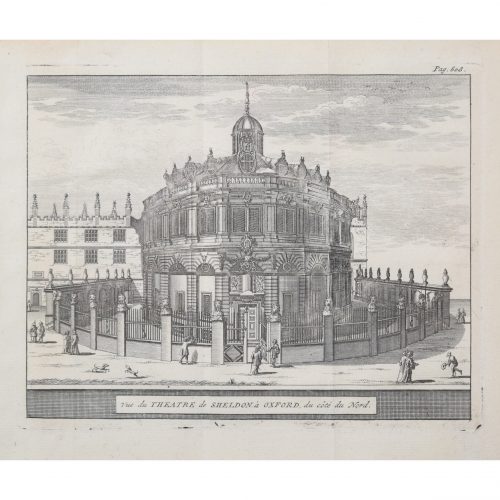
Pieter van der Aa (1659-1733), after David Loggan (1634–1692)
The Sheldonian Theatre, University of Oxford (1727)
Engraving 12 x 16 cm An eighteenth-century view of Oxford's marvellous Sheldonian Theatre, engraved by Pieter van der Aa after David Loggan, the noted engraver, draughtsman, and painter. Christopher Wren designed the building and it was constructed between 1664 and 1669; it takes its name from Gilbert Sheldon, chancellor of the University at the time and the Theatre's main financial backer. Pieter van der Aa of Leiden was a Dutch publisher best known for preparing maps and atlases, though he also printed editions of foreign bestsellers and illustrated volumes. He is noted for the many engravings he produced after David Loggan's series of Oxford and Cambridge colleges and costumes. In 1727 Van Der Aa illustrated "Les Delices de la Grande Bretagne & de L'Irelande" by James Beeverell, the book in which this engraving appears. Condition: a good impression. If you’d like to know more, please email info@manningfineart.co.uk or call us on 07929 749056.

